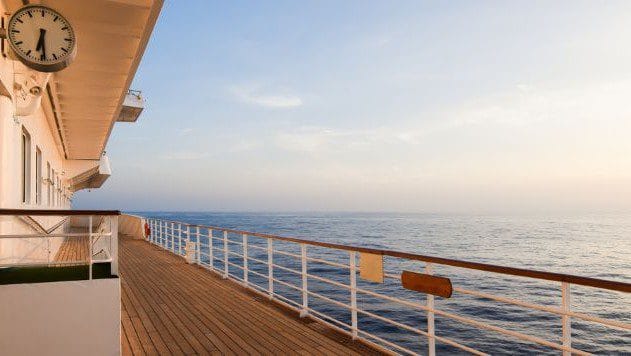Transatlantic voyages were more than just trips from one place to another. They were full of unique traditions, rituals, and customs. These practices often reflected the anxieties, superstitions, and sense of community among those at sea. From warding off bad luck to celebrating milestones, these rituals provide a vivid glimpse into life on these historic journeys.
Here are 10 fascinating and strange traditions that made transatlantic voyages a unique experience.
The Yarn Goodbye
One of the most heartwarming traditions was the “yarn goodbye.” In the 19th and early 20th centuries, as ships prepared to leave, passengers and their loved ones on the dock would each hold one end of a ball of yarn. As the ship sailed away, the yarn unraveled. It symbolized the bittersweet separation. This custom was common among immigrants leaving Europe for America, many saying goodbye to their families forever. Later, yarn was replaced with streamers.
The unraveling yarn wasn’t just symbolic. It gave families a tangible connection during those final moments. Ports like Liverpool and Hamburg were filled with people holding colorful strands of yarn, creating a poignant scene of connection and loss. Some passengers kept the remaining yarn as a reminder of their loved ones back home, a small but meaningful piece of the life they had left behind.
The Crossing the Line Ceremony
The “Crossing the Line” ceremony was performed for first-timers crossing the equator. It was a flamboyant and often chaotic tradition on many transatlantic ships. This ritual turned the ship into a stage for theatrics. Senior crew members dressed as King Neptune, his wife Amphitrite, and their court. Newcomers, called “pollywogs,” underwent initiation, including mock trials and messy pranks.
Though more common on naval and merchant ships, it sometimes appeared on transatlantic liners. On luxury liners, the ceremony was more refined. In steerage, it could get rowdy, with passengers improvising their own versions. Some accounts describe disputes, while others recall it as the highlight of long journeys. The tradition boosted morale and created an unforgettable experience.
Wearing Amulets for Safe Passage
Superstition played a big role for those on transatlantic voyages. Passengers and sailors carried amulets and charms for protection. These items varied by culture and religion. Catholic passengers often carried rosaries or medals of St. Christopher. Others used coins, seashells, or holy water.
Sailors had their own superstitions, like avoiding sailing on Fridays or whistling on deck. Immigrants combined religious rituals with these superstitions, hoping their charms would protect them from shipwrecks, illness, or bad fortune. Staff at Ellis Island saw passengers clutching these items, reminders of the spiritual protection they relied on.
The Last Night’s Concert
The final night aboard was often marked by a concert or performance. On luxury liners like the Titanic and Queen Mary, first-class passengers enjoyed elegant soirées with live orchestras and champagne toasts. These events showcased luxury and entertainment.
In steerage, celebrations were more modest but heartfelt. Passengers organized impromptu concerts with folk songs and dances. Immigrants from Ireland, Italy, and Eastern Europe brought their musical traditions, turning the lower decks into vibrant hubs. These gatherings created friendships and shared stories, even with language barriers. Passengers used these concerts to say farewell to their old lives, with songs of hope and nostalgia.
Saltwater Showers as a Rite of Passage

Fresh water was precious, so saltwater showers were a necessity and a tradition. Passengers, especially in steerage, lined up on deck to be doused with buckets of seawater or used makeshift saltwater pumps. These showers cooled them off or freshened them up after days in cramped quarters.
Saltwater showers were symbolic for sailors, marking milestones. For passengers, they brought levity and community, with children splashing each other and adults laughing. On some ships, they were daily. First-class passengers rarely participated, as they had private baths with fresh water, highlighting the class differences.
Tossing Coins into the Ocean
Passengers tossed coins into the sea for good luck. This practice came from ancient beliefs that offerings to sea gods could ensure calm waters. On transatlantic voyages, it was a way to honor the unknown dangers ahead.
For many immigrants, tossing a coin symbolized leaving their old lives. Some families tossed coins engraved with initials or dates, as spiritual insurance. Children were excited to see their coins disappear into the waves. Crew members joked about the sea’s growing “collection,” but it held deep meaning for those making the crossing.
Dining Salutes and Table Etiquette
Dining was as much about ritual as sustenance, especially for first-class passengers. Meals were multi-hour affairs with up to ten courses, served by tuxedoed waiters. Passengers participated in formal dining salutes, raising glasses to the captain. Seating arrangements reflected social hierarchies.
In steerage, dining was less glamorous. Meals included bread, porridge, salted meat, and potatoes, served in communal areas. Immigrant families shared stories and songs, swapping recipes. The contrast between the upper-deck elegance and the communal atmosphere of steerage showed the class divides of transatlantic life.
Blessing the Ship Before Departure
Before a ship left port, a blessing was performed for safe passage. In Catholic countries, priests sprinkled holy water and offered prayers. Passengers, especially immigrants, brought religious items to be blessed.
Jewish passengers recited the Tefilat HaDerech (Traveler’s Prayer), while others performed personal rituals. Dockworkers and sailors participated, seeing it as a communal act. During maritime disasters, these blessings took on a desperate urgency, with families praying at the port before the ship sailed.
The Iceberg Vigil
After the Titanic tragedy in 1912, an unofficial tradition emerged: the iceberg vigil. Passengers, especially in steerage, gathered on deck at night to watch for icebergs. Though ships had better safety measures, the memory of the Titanic remained, making this a way for passengers to feel involved in their safety.
The vigil became a communal activity. Passengers shared stories and jokes. Crew members joined in, adding their expertise. While these gatherings had little practical effect, they provided solidarity and control when many felt at the mercy of the ocean.
Tying Ribbons to the Mast

A lesser-known tradition involved tying ribbons to the ship’s mast before departure. Each ribbon represented a wish or prayer for the voyage. Some passengers tied multiple ribbons for different desires, like safe passage or success in their new home. The ribbons were a visual reminder of the hopes carried by the ship and its passengers.
This tradition was popular among immigrants and sailors from Central and Eastern Europe, where ribbons symbolized protection and good fortune. Ribbons were tied in specific colors to represent different wishes. By the time the ship reached its destination, the ribbons were weathered, a metaphor for the trials endured during the journey.
These traditions and rituals added depth to the transatlantic voyage experience. They reflect the hopes, fears, and sense of community among those who crossed the ocean. Which tradition did you find most interesting? Leave your comment below!










